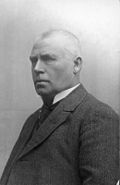File:Hvalsmoen - no-nb digifoto 20140703 00014 NB NS NM 01892.jpg

Original file (7,210 × 5,410 pixels, file size: 2.82 MB, MIME type: image/jpeg)
Captions
Captions
Summary
[edit]| DescriptionHvalsmoen - no-nb digifoto 20140703 00014 NB NS NM 01892.jpg |
English: Six soldiers from the Norwegian Army (Norwegian: Hæren) equipped with military field gear at Hvalsmoen military camp north of Hønefoss, Norway.
Norsk bokmål: Bildet er hentet fra Nasjonalbibliotekets bildesamling. Beskrivelse: Felt-telegraf, felttelegraf, telegraf, militære; Påskrift eske: Hvalsmoen; Påskrift negativ: Hvalsmoen
|
|||||||||||||||||||||||||
| Date |
between circa 1910 and circa 1916 date QS:P,+1910-00-00T00:00:00Z/8,P1319,+1910-00-00T00:00:00Z/9,P1326,+1916-00-00T00:00:00Z/9,P1480,Q5727902 |
|||||||||||||||||||||||||
| Source |
institution QS:P195,Q924551 |
|||||||||||||||||||||||||
| Author |
creator QS:P170,Q15979725 |
|||||||||||||||||||||||||
| Other versions |
|
|||||||||||||||||||||||||
Licensing
[edit]| Public domainPublic domainfalsefalse |
| This image is in the public domain in Norway because images not considered to be "works of art" become public domain 50 years after creation, provided that more than 15 years have passed since the photographer's death or the photographer is unknown.
This is according to § 23 in the Norwegian Åndsverkloven. Under the former photo law, protection ended 25 years after creation, provided that more than 15 years had passed since the photographer's death or the photographer is unknown. The image is in the public domain if the protection ended before 29 June 1995 under the older term.[4] To uploader: Please provide information about where the image was first published, who created it, and when the photographer died, if known. The right to be attributed does not expire in Norway.
Images uploaded to Wikimedia Commons must also be in the public domain in the United States. A Norwegian work that is in the public domain in Norway is in the public domain in the U.S. only if it was in the public domain in Norway in 1996 and no copyright was registered in the U.S. (This is the effect of 17 USC 104A with its critical date of January 1, 1996.) Deutsch | English | македонски | Nederlands | norsk nynorsk | +/− |
 |
File history
Click on a date/time to view the file as it appeared at that time.
| Date/Time | Thumbnail | Dimensions | User | Comment | |
|---|---|---|---|---|---|
| current | 14:08, 18 September 2014 |  | 7,210 × 5,410 (2.82 MB) | Nasjonalbiblioteket-bot (talk | contribs) | From the Norwegian National Library: Narve Skarpmoen - 1900-1931 |
You cannot overwrite this file.
File usage on Commons
The following 8 pages use this file:
- File:Gardermoen 1912, Vidkun Quisling lengst til venstre..jpg
- File:Hvalsmoen - no-nb digifoto 20140703 00014 NB NS NM 01892.jpg
- File:Hvalsmoen leir Ringerike Army of Norway Hæren Feltartilleriet field artillery mounted Vidkun Quisling (1887-1945) premierløytnant til hest ca 1910-16 Skarpmoen Nasjonalbiblioteket URN NBN no-nb digifoto 20210721 00139 NB NS NM 01914.jpg
- File:Hvalsmoen leir Ringerike Army of Norway Hæren Sambandstropp Vidkun Quisling (1887-1945) premierløytnant feltartilleri ca 1910 16 Skarpmoen Nasjonalbiblioteket URN NBN no-nb digifoto 20210721 00127 NB NS 000038Z cropped.jpg
- File:Hvalsmoen leir Ringerike Army of Norway Hæren uniforms equipment binoculars signal corps flag Sambandtropp Quisling (feltartilleri) ca 1910-14? Skarpmoen Nasjonalbiblioteket URN NBN no-nb digifoto 20210721 00127 NB NS 000038Z.jpg
- File:Hvalsmoen leir Ringerike Army of Norway Hæren uniforms equipment soldiers Feltartilleriet field artillery Quisling til hest ca 1910-14? Skarpmoen Nasjonalbiblioteket URN NBN no-nb digifoto 20210721 00139 NB NS NM 01914 PD.jpg
- File:Hvalsmoen leir Ringerike Army of Norway Hæren uniforms equipment soldiers felt-telegraf sykkel ordonnans Signal troops samband etc ca 1910-14? N Skarpmoen Nasjonalbiblioteket URN NBN no-nb digifoto 20210721 00074 NB NS NM 01857.jpg
- File:Hvalsmoen leir Ringerike Army of Norway Hæren uniforms equipment spotting scope signal flag Sambandstropp semafor etc ca 1910-14? N Skarpmoen Nasjonalbiblioteket URN NBN no-nb digifoto 20210721 00079 NB NS NM 01862.jpg
File usage on other wikis
The following other wikis use this file:
- Usage on no.wikipedia.org
Metadata
This file contains additional information such as Exif metadata which may have been added by the digital camera, scanner, or software program used to create or digitize it. If the file has been modified from its original state, some details such as the timestamp may not fully reflect those of the original file. The timestamp is only as accurate as the clock in the camera, and it may be completely wrong.
| Short title |
|
|---|---|
| Author | Narve Skarpmoen |
| Image title |
|
| City shown | Ringerike |
| Identifier | URN:NBN:no-nb_digifoto_20140703_00014_NB_NS_NM_01892 |
| Country shown | Norge |
| Province or state shown | Buskerud |
| Sublocation of city shown | Hvalsmoen |
| Keywords | Felt-telegraf, felttelegraf, telegraf, militære |
- Photographs by Narve Skarpmoen
- Historical images of Ringerike
- History of telecommunications in Norway
- Soldiers of Norway
- Military telegraphy
- Hvalsmoen leir
- Vidkun Quisling before 1940
- Military tents
- Tents in Norway
- Signal units and formations
- Bicycles in Norway
- Military bicycles
- Military uniforms of Norway (20th century)
- Military history of Norway









